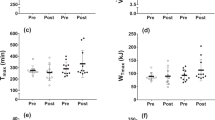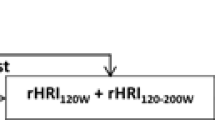Abstract
We investigated the effect of hydrotherapy on time-trial performance and cardiac parasympathetic reactivation during recovery from intense training. On three occasions, 18 well-trained cyclists completed 60 min high-intensity cycling, followed 20 min later by one of three 10-min recovery interventions: passive rest (PAS), cold water immersion (CWI), or contrast water immersion (CWT). The cyclists then rested quietly for 160 min with R–R intervals and perceptions of recovery recorded every 30 min. Cardiac parasympathetic activity was evaluated using the natural logarithm of the square root of mean squared differences of successive R–R intervals (ln rMSSD). Finally, the cyclists completed a work-based cycling time trial. Effects were examined using magnitude-based inferences. Differences in time-trial performance between the three trials were trivial. Compared with PAS, general fatigue was very likely lower for CWI (difference [90% confidence limits; −12% (−18; −5)]) and CWT [−11% (−19; −2)]. Leg soreness was almost certainly lower following CWI [−22% (−30; −14)] and CWT [−27% (−37; −15)]. The change in mean ln rMSSD following the recovery interventions (ln rMSSDPost-interv) was almost certainly higher following CWI [16.0% (10.4; 23.2)] and very likely higher following CWT [12.5% (5.5; 20.0)] compared with PAS, and possibly higher following CWI [3.7% (−0.9; 8.4)] compared with CWT. The correlations between performance, ln rMSSDPost-interv and perceptions of recovery were unclear. A moderate correlation was observed between ln rMSSDPost-interv and leg soreness [r = −0.50 (−0.66; −0.29)]. Although the effects of CWI and CWT on performance were trivial, the beneficial effects on perceptions of recovery support the use of these recovery strategies.




Similar content being viewed by others
References
Al Haddad H, Laursen P, Chollet D, Lemaitre F, Ahmaidi S, Buchheit M (2010) Effect of cold or thermoneutral water immersion on post-exercise heart rate recovery and heart rate variability indices. Auto Neurosci 156(1–2):111–116
Barnett A (2006) Using recovery modalities between training sessions in elite athletes: does it help? Sports Med 36:781–796
Bleakley CM, Davison GW (2010) What is the biochemical and physiological rationale for using cold-water immersion in sports recovery? A systematic review. Br J Sports Med 44:179–187
Bloomfield DM, Magnano A, Bigger JT Jr, Rivadeneira H, Parides M, Steinman RC (2001) Comparison of spontaneous vs. metronome-guided breathing on assessment of vagal modulation using RR variability. Am J Physiol Heart Circ Physiol 280:H1145–H1150
Buchheit M, Gindre C (2006) Cardiac parasympathetic regulation: respective associations with cardiorespiratory fitness and training load. Am J Physiol Heart Circ Physiol 291:H451–H458
Buchheit M, Laursen PB (2009) Treatment of hyperthermia: is assessment of cooling efficiency enough? Exp Physiol 94:627–629
Buchheit M, Laursen PB, Ahmaidi S (2007) Parasympathetic reactivation after repeated sprint exercise. Am J Physiol Heart Circ Physiol 293:H133–H141
Buchheit M, Peiffer JJ, Abbiss CR, Laursen PB (2009) Effect of cold water immersion on postexercise parasympathetic reactivation. Am J Physiol Heart Circ Physiol 296:H421–H427
Buchheit M, Chivot A, Parouty J, Mercier D, Al Haddad H, Laursen PB, Ahmaidi S (2010) Monitoring endurance running performance using cardiac parasympathetic function. Eur J Appl Physiol 108:1153–1167
Burke L (2006) Nutrition for recovery after training and competition. In: Burke L, Deakin V (eds) Clinical sports nutrition. McGraw-Hill, North Ryde, pp 415–453
Cohen J (1988) Statistical power analysis for behavioral sciences. Lawrence Erlbaum Associates, Hillsdale
Crowe MJ, O’Connor D, Rudd D (2007) Cold water recovery reduces anaerobic performance. Int J Sports Med 28:994–998
Currell K, Jeukendrup AE (2008) Superior endurance performance with ingestion of multiple transportable carbohydrates. Med Sci Sports Exerc 40:275–281
Gabrielsen A, Warberg J, Christensen NJ, Bie P, Stadeager C, Pump B, Norsk P (2000) Arterial pulse pressure and vasopressin release during graded water immersion in humans. Am J Physiol Regul Integr Comp Physiol 278:R1583–R1588
Garet M, Tournaire N, Roche F, Laurent R, Lacour JR, Barthélémy JC, Pichot V (2004) Individual interdependence between nocturnal ANS activity and performance in swimmers. Med Sci Sports Exerc 36:2112–2118
Halson SL, Jeukendrup AE (2004) Does overtraining exist? An analysis of overreaching and overtraining research. Sports Med 34:967–981
Halson S, Quod MJ, Martin DT, Gardner AS, Ebert TR, Laursen PB (2008) Physiological responses to cold water immersion following cycling in the heat. Int J Sports Physiol Perform 3:331–346
Hautala AJ, Tulppo MP, Mäkikallio TH, Laukkanen R, Nissilä S, Huikuri HV (2001) Changes in cardiac autonomic regulation after prolonged maximal exercise. Clin Physiol 21:238–245
Higgins D, Kaminski TW (1998) Contrast therapy does not cause fluctuations in human gastrocnemius intramuscular temperature. J Athl Train 33:336–340
Hjortskov N, Rissén D, Blangsted A, Fallentin N, Lundberg U, Søgaard K (2004) The effect of mental stress on heart rate variability and blood pressure during computer work. Eur J Appl Physiol 92:84–89
Hopkins WG (2006) Spreadsheets for analysis of controlled trials with adjustment for a subject characteristic. Sportscience 10:46–50 (sportsci.org/2006/wghcontrial.htm)
Hopkins WG, Marshall SW, Batterham AM, Hanin J (2009) Progressive statistics for studies in sports medicine and exercise science. Med Sci Sports Exerc 41:3–13
Jeukendrup AE, Saris WHM, Brouns F, Kester ADM (1996) A new validated endurance performance test. Med Sci Sports Exerc 28:266–270
Lane KN, Wenger HA (2004) Effect of selected recovery conditions on performance of repeated bouts of intermittent cycling separated by 24 hours. J Strength Cond Res 18:855–860
Mair SD, Seaber AV, Glisson RR, Garrett WE (1996) The role of fatigue in susceptibility to acute muscle strain injury. Am J Sports Med 24:137–143
Marcora SM, Staiano W, Manning V (2009) Mental fatigue impairs physical performance in humans. J Appl Physiol 106:857–864
Miwa C, Sugiyama Y, Mano T, Iwase S, Matsukawa T (1997) Sympatho-vagal responses in humans to thermoneutral head-out water immersion. Aviat Space Environ Med 68:1109–1114
Montgomery PG, Pyne DB, Hopkins WG, Dorman JC, Cook K, Minahan CL (2008) The effect of recovery strategies on physical performance and cumulative fatigue in competitive basketball. J Sports Sci 26:1135–1145
Mourot L, Bouhaddi M, Gandelin E, Cappelle S, Dumoulin G, Wolf JP, Rouillon JD, Regnard J (2008) Cardiovascular autonomic control during short-term thermoneutral and cool head-out immersion. Aviat Space Environ Med 79:14–20
Myllymäki T, Kyröläinen H, Savolainen K, Hokka L, Jakonen R, Juuti T, Martinmäki K, Kaartinen J, Kinnunen M, Rusko H (2010) Effects of vigorous late-night exercise on sleep quality and cardiac autonomic activity. J Sleep Res (Epub ahead of print). doi:10.1111/j.1365-2869.2010.00874.x
Park KS, Choi JK, Park YS (1999) Cardiovascular regulation during water immersion. Appl Human Sci 18:233–241
Parouty J, Al Haddad H, Quod M, Leprêtre PM, Ahmaidi S, Buchheit M (2010) Effect of cold water immersion on 100-m sprint performance in well-trained swimmers. Eur J Appl Physiol 109:483–490
Peiffer J, Abbiss C, Watson G, Nosaka K, Laursen P (2009) Effect of cold-water immersion duration on body temperature and muscle function. J Sports Sci 27:987–993
Penttilä J, Helminen A, Jartti T, Kuusela T, Huikuri H, Tulppo M, Coffeng R, Scheinin H (2001) Time domain, geometrical and frequency domain analysis of cardiac vagal outflow: effects of various respiratory patterns. Clin Physiol 21:365–376
Perini R, Orizio C, Baselli G, Cerutti S, Veicsteinas A (1990) The influence of exercise intensity on the power spectrum of heart rate variability. Eur J Appl Physiol 61:143–148
Schniepp J, Campbell TS, Powell KL, Pincivero DM (2002) The effects of cold-water immersion on power output and heart rate in elite cyclists. J Strength Cond Res 16:561–566
Seiler KS, Kjerland GØ (2006) Quantifying training intensity distribution in elite endurance athletes: is there evidence for an “optimal” distribution? Scand J Med Sci Sports 16:49–56
Seiler S, Haugen O, Kuffel E (2007) Autonomic recovery after exercise in trained athletes: intensity and duration effects. Med Sci Sports Exerc 39:1366–1373
Task-Force (1996) Heart rate variability: standards of measurement, physiological interpretation, and clinical use. Circulation 93:1043–1065
Vaile J, Halson S, Gill N, Dawson B (2008) Effect of hydrotherapy on recovery from fatigue. Int J Sports Med 29:539–544
Vaile J, O’Hagan C, Stefanovic B, Walker M, Gill N, Askew CD (2010) Effect of cold water immersion on repeated cycling performance and limb blood flow. Br J Sports Med (Epub ahead of print). doi:10.1136/bjsm.2009.067272
Versey N, Halson S, Dawson B (2011) Effect of contrast water therapy duration on recovery of cycling performance: a dose-response study. Eur J Appl Physiol 111:37–46
Vianna LC, Oliveira RB, Silva BM, Ricardo DR, Araujo CGS (2008) Water intake accelerates post-exercise cardiac vagal reactivation in humans. Eur J Appl Physiol 102:283–288
Yeargin SW, Casa DJ, McClung JM, Knight JC, Healey JC, Goss PJ, Harvard WR, Hipp GR (2006) Body cooling between two bouts of exercise in the heat enhances subsequent performance. J Strength Cond Res 20:383–389
Acknowledgments
The authors would like to acknowledge and thank the athletes for their generous time commitment and effort throughout the study. This study was supported by the Centre of Excellence for Applied Sports Science Research at the Queensland Academy of Sport, Brisbane.
Author information
Authors and Affiliations
Corresponding author
Additional information
Communicated by Narihiko Kondo.
Rights and permissions
About this article
Cite this article
Stanley, J., Buchheit, M. & Peake, J.M. The effect of post-exercise hydrotherapy on subsequent exercise performance and heart rate variability. Eur J Appl Physiol 112, 951–961 (2012). https://doi.org/10.1007/s00421-011-2052-7
Received:
Accepted:
Published:
Issue Date:
DOI: https://doi.org/10.1007/s00421-011-2052-7




